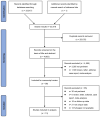Incidence of Gastric Neoplasms Arising from Autoimmune Metaplastic Atrophic Gastritis: A Systematic Review and Case Reports
- PMID: 36769710
- PMCID: PMC9918256
- DOI: 10.3390/jcm12031062
Incidence of Gastric Neoplasms Arising from Autoimmune Metaplastic Atrophic Gastritis: A Systematic Review and Case Reports
Abstract
Autoimmune metaplastic atrophic gastritis (AMAG) is associated with an increased risk of gastric neoplasms. This study aimed to systematically analyze the incidence rate of gastric cancer (GC), low-grade dysplasia (LGD) and type-1 gastric neuroendocrine tumor (gNETs) development in AMAG adults. Studies on AMAG patients reporting the incidence of gastric neoplasms was identified through a systematic search in PUBMED and EMBASE. Study quality was assessed using the Joanna Briggs Institute quality assessment tool. Incidence rates of GC, LGD and type-1 gNETs were examined by meta-analysis. Thirteen studies met eligibility criteria. Incidence rate of gastric cancer calculated from the pooled data was 0.14% per person-year in both single-center studies and national registration studies. Meta-analysis showed a relative risk of 11.05 (95% CI: 6.39-19.11) for gastric cancer development in AMAG patients. The calculated pooled gastric LGD and type-1 gNETs incidence rates were 0.52% and 0.83% per person-year, respectively. As for experience from our center, we presented three distinctive cases of gastric neoplasm arising from the background of AMAG. This study underscores the potential for malignant transformation of precancerous lesions and reiterates the importance of careful esophagogastroduodenoscopy screening.
Keywords: autoimmune metaplastic atrophic gastritis; dysplasia; gastric cancer; gastric hyperplastic polyps; neuroendocrine tumor; pernicious anemia.
Conflict of interest statement
The authors declare no conflict of interest.
Figures







References
-
- Mårdh S., Song Y.H. Characterization of antigenic structures in auto-immune atrophic gastritis with pernicious anaemia. The parietal cell H,K-ATPase and the chief cell pepsinogen are the two major antigens. Acta Physiol. Scand. 1989;136:581–587. doi: 10.1111/j.1748-1716.1989.tb08705.x. - DOI - PubMed
Grants and funding
LinkOut - more resources
Full Text Sources
Medical
Research Materials
Miscellaneous

